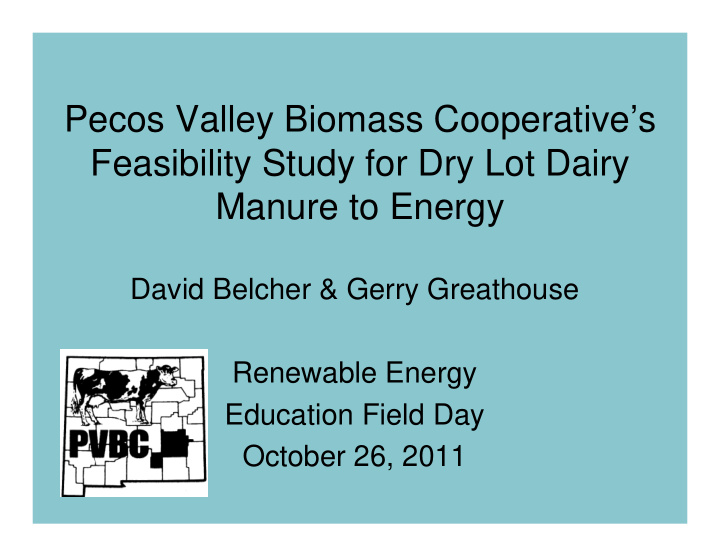



Pecos Valley Biomass Cooperative’s Feasibility Study for Dry Lot Dairy Manure to Energy David Belcher & Gerry Greathouse Renewable Energy Education Field Day October 26, 2011
Background • NM = Dry lot dairies in hot arid conditions • Traditional digestion has not been successful for this type of dairy production • Pecos Valley Biomass Coop represents 23 dairies & 60,000 milking cows and was formed to identify suitable technologies • DOE funding was provided to support completion of a comprehensive technical & economic feasibility study
Typical New Mexico Drylot Dairy Open Lot Area Feed Apron
Feasibility Study Sampling • Three different sample events to collect manure solids from 3 different sources: – Daily (feed apron) scrape – Weekly (whole corral area) scrape – Greenwater (milking parlor flush) • Aug ‘09 – Mar ’10: 29 WS samples from 6 dairies (avg sample size = 46 tons) • Aug ‘10 – Sep ‘10: 18 WS and DS samples, 3 dairies (avg size = 40 tons) • Dec ‘10 – Mar ’11: 20 DS samples, 1 dairy, (avg sample size = 5.7 tons)
Sampling
Sampling
Sample Analysis • Wet Chemistry (e.g. TS, VS, COD, BOD5, pH, N, P) • Biomethane Production (BMP) potential • Combustion (e.g. proximate/ultimate analysis, ash fusion temperature)
Sample Biomethane Potential (BMP) Testing Results •Daily Scrape •As-Excreted •Weekly Scrape •Greenwater •Seed Stock Average BMP for Weekly Scrape = 0.18 mL CH 4 /mg VS loaded Average BMP for Daily Scrape = 0.28 mL CH 4 /mg VS loaded Average BMP for As Excreted Manure = 0.32 mL CH 4 /mg VS loaded
avg = 41.1% moisture HHV = 2146 BTU/lb avg HHV = 3686 BTU/lb at 0% moisture
Summary • There is variation in quantity and quality of manure solids recovered between drylot dairies (attributed to variations in weather and dairy farm practices) • The digestion potential of manure decreases over time as solids weather and are scraped/moved around the pen area
Summary – cont. • Do not attempt to mix and digest all corral scrape solids • Apron scrape manure solids (collected daily) have good digestion potential • Corral scrape solids are not suitable for digestion unless inorganic fraction can be removed • Drylot manure solids have combustion potential
Thanks to: • Senator Jeff Bingaman • US Department of Energy • Mike McCloskey and Select Milk Producers, Inc. • New Mexico Dairy Producers Association • NMSU Dairy Extension
Recommend
More recommend